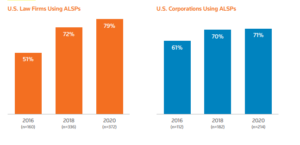The Alternative Legal Service Providers 2021 survey results are out!
(I am talking about the much-anticipated third biennial survey produced by Thomson Reuters in partnership with The Center on Ethics and the Legal Profession at Georgetown Law and the Saïd Business School at the University of Oxford that came out last week. Any images used in this post are from that report which you can find as the top listing under the announcement section here.)
Below are some highlights from their excellent report along with some of our reactions and comments.
ALSP use is becoming more mainstream for both law departments and law firms


The ALSP market is now estimated to have $14 billion in revenue and it appears to be on an exponential growth trajectory. Nearly 80% of law firms and more than 70% of law departments surveyed report they now use ALSPs.
“Captive ALSPs” [see our note below] have grown the fastest over the years (30% CAGR between 2017 to 2019) but they represent the smallest category of ALSPs in this group. Independent ALSPs are next-fastest (15% CAGR) and they also command the largest portion of the ALSP market share (about 85% of it). The Big Four have been a little slower (8% CAGR).
Our note on “Captive ALSP” growth rate: many firms say they have captives that are not true captives but use this term for marketing purposes and to test new initiatives, so do not take this stat to heart other than to realize firms are trying new things, which is great. Many law firm Captive ALSPs outsource to Independent ALSPs as well.
“There is a clear need in the market for cost-efficient and cost-certain solutions, and for measurable legal output reported through management information and dashboards. Converting legal documents into digital information creates huge potential for future savings and risk control.”
Our comment: get onto the digital bandwagon, plus find other areas for improvement along every part of your processes. Improve a process and rely on outside support where it makes sense along that process. There is still a tremendous amount of margin you can squeeze from doing things more efficiently, pricing things differently, and leveraging outside support, where possible, to benefit from others’ ready-to-go technology resources, expertise, and lower-cost labor.
“The Big Four continue to be hampered by regulation in some markets and appear to be shifting their focus to a more ‘client issues-led’ and ‘consulting-based’ approach – two areas the Big Four are highly adept in.”
Our comment: the Big Four can get into the game without practicing law. The Big Four, from a consultative standpoint, can approach your clients and say “look at this from a business perspective. This primarily may be a business problem with some legal components; let’s break it down into parts to see where outside counsel and other service providers, whether legal or not, should be involved. Not all of this is legal, so maybe your law firm shouldn’t handle it all.”
But I counter that law firms can also take this same consultative approach. And, where the Big Four might outsource work to ALSPs and other service providers, law firms can access many of those same service providers and similarly get the job done. To me, this consultative approach is a matter of semantics. Yes, framed as a business problem rather than a legal problem, law firms can also help clients solve their problems with right-sized resources, but law firms must first be aware of these resources!
Why some law departments and law firms still hesitate to use ALSPs
“Half of law firms and corporations still harbor some doubts about the
quality and security of the ALSP offering. But these negative perceptions are declining.”
Our comment on security: there are many ALSPs out there. I am aware of hundreds of them. And I would not recommend some of them. There are many, however, that I would recommend. In fact, some ALSPs are more secure than most law firms.
Our comment regarding cost: I ponder whether some of the larger ALSPs are too hierarchical and top-heavy to offer reasonable cost-savings over the long run, so be careful how intertwined your firm becomes with these larger players, because they may just end up looking like another law firm with similar revenue and profitability challenges. However, if you are finding it difficult to find an ALSP that provides real cost savings on quality work, that’s because you aren’t aware of some of the excellent ALSPs out there. Let me give you an example of what you might be missing:
| Have a busy immigration practice? Handle or want to handle more visa applications?
You can offer a competitive flat fee to your clients for H1Bs, have an ALSP handle 85% of that work for only $350, your firm does the rest and keeps whatever amount you’ve charged above $350 for the 15% of the work that directly involved you. Then, your client wins because you continue to provide quality service at a good price; you win because you retain the client relationship, control the quality of work, improve your profitability, and can scale up or down your use of an ALSP according to utilization needs. Win-win. |
I have additional thoughts on this report and insights into the ALSP market. If you are curious to learn more, you can find additional information about ALSPs on ALSPadvisor.com or email me here: ynath@lawvision.com.

